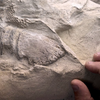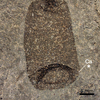Siberian Mammoth Statue Gets a Christmas Makeover

The Salekhard mammoth, ready for Christmas
Just below the Arctic Circle, a roadside mammoth statue welcomes visitors to Salekhard, the capital of Siberia’s Yamalo-Nenets province. Standing 10 meters tall and made of bronze, the statute is an approximation of the massive woolly mammoths that once roamed across Siberia during the Pleistocene Epoch, beginning two and a half million years ago. These megafauna giants were well suited to the inhospitable conditions of the last Ice Age, with their thick coats of coarse hair and fat deposits protecting them from the cold. Siberia is home to many of the world’s woolly mammoth fossils, the giants tied to the region’s culture and identity.
In 2016, the Salekhard mammoth got a makeover for the Christmas season. Inspired by a kindergartener’s drawing, the local government decked the statue out in a red Santa hat and coat made up of 150 meters of fabric, adorned with 40 meters of artificial fur. After a month of cutting, sewing, and fitting, the massive costume was finally unveiled. With its new outfit, the Salekhard mammoth joined a long lineage of Russian wintertime figures like Ded Moroz, a Santa Claus-type figure from Slavic folklore, and the Snow Maiden Snegurochka, his companion who helps award good children on New Year’s Eve.

Paleoart of the Adams Mammoth, the first documented mammoth fossil with preserved skin
Because woolly mammoths have only recently become extinct, their remains are well-preserved in the tough Siberian permafrost. As such, we are always learning new things about these towering animals. A 2021 paper published in Nature sought to do just that by investigating 535 genomic samples across 50,000 years in order to reconstruct the mammoth biome and its environment. It found that woolly mammoths and other megafauna lived as recently as 3,900 years ago in Siberia. Prior to this, it was thought that the only mammoth populations to survive to that point did so on Wrangle Island, but it seems mammoths were still flourishing on the mainland.
This finding is significant because it suggests that the woolly mammoth’s extinction was tied more directly to the Holocene Epoch’s warming climate than hunting from humans, as had been assumed. The woolly mammoth’s life and death is something of a biological catch-22: as an animal evolves and becomes suited to its specific environment, it is then at greater risk when that environment changes. But while the woolly mammoth is gone, it is still remembered across the Arctic Circle in places like Salekhard, with its jolly mammoth proving a welcome sight amidst the bitter arctic environment.
Interested in getting ahold of some mammoth material? Mini Museum has you covered with meat, hair, and tooth specimens. Check out our mammoth-sized mammoth collection!
Featured Product
Joe Frazier Boxing Glove
Cool Things!

Is “Paul is Dead” Dead?: Unpacking One Of Pop Culture’s Most Enduring Conspiracy Theories

Scientists Discover Hooves and Skin in Preserved Dinosaur "Mummies!"
A dinosaur discovery just in time for Halloween! In a new analysis of a group of fossils from Wyoming, Scientists have determined this group of fossils are dinosaur “mummies,” with preserved skin and even hooves.

Scientists Record a Bat Catching Birds Mid-Flight!
Bats, birds, screeches, oh my! In a reverse-Hitchcock twist, a new study reveals that a species of European bat catches and eats birds mid-flight.
Specimen Deep Dives

The House that Ruth Built: The Story of the Old Yankee Stadium

The Queen of the Skies: the Story of the Boeing 747

Old Ironsides: The USS Constitution and the Start of the U.S. Navy
Long Form Articles

The Artist Behind the Macintosh: Susan Kare and Apple Computers
While the two Steves, Jobs and Wozniak, are the most well known faces behind Apple computers, equally important to the products and culture of the company were those who crafted the experience of using their computers through design. The most notable of these visual architects was Susan Kare, a designer responsible for “humanizing” Macintosh computers.

Can I Lick It? Yes You Can!
Have you ever been unable to tell if a fossil was really a fossil, but you were too embarrassed to admit it? Have you ever wanted to lick a fossil just because, but you didn’t want to risk judgment from your peers? Well, good news! You can kill two birds with one stone! Licking a fossil can actually help you determine if it’s the real deal or just another rock.

Is It Legal To Own a Meteorite: How to Start Your Outer Space Collection!
Meteorites are some of the rarest geological specimens to be found on Earth. Of course, since these stones are not of our world, purchasing them can sometimes be a confusing process. Is it legal to own a meteorite? In short, yes! Read on for help starting your cosmic collection!


















